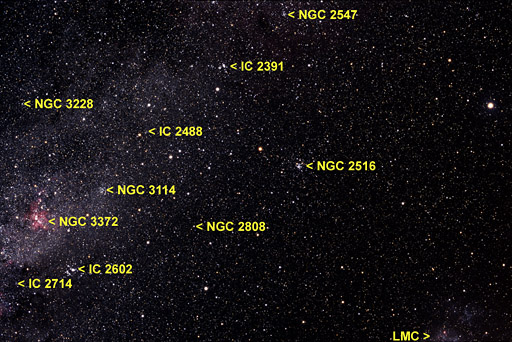
Names:
| English: | Keel, Flying Fish | Spanish: | Quilla de la Nave Argo, Pez Volador |
|---|---|---|---|
| German: | Kiel, Fliegender Fisch | French: | Carène, Poisson Volant |
The field of Carina is a wonderful milky way region with much structure and many bright stars. This makes it not easy picking out the constellation pattern of Carina and also the smaller Volans (see lines). The very bright star in the West (right hand side) is Canopus or alpha Carinae. With -0.72 mag it is the second brightest star of the entire night sky after Sirius. Just north of Carina are the constellations Vela and Puppis. Carina (the keel), Puppis (the stern), and Vela (the sails) together form the ship Argo. This was the former designation of this huge star field.
Best observing time in mid of March is about 21:30 (9:30 pm) local time. The declination of the constellation borders ranges from -75o to -51o. So you should be on the southern hemisphere for a good observation. To see Canopus, which is just about 35 degrees south of Sirius, you at least should be below latitude 37 degrees north.
There are several interesting deep sky objects in this rich milky way field. Many can be seen by naked eye like the southern Pleiades (IC 2602) and the Eta Carinae Nebula (NGC 3372). It is an awesome field for observing with a pair of binoculars or a telescope at low magnification.